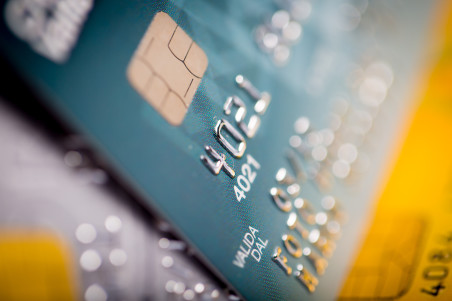5 Ways to Stay On Track When You’re Paying Off Credit Card Debt

If you’ve recently made the commitment to get your financial life back on track, chances are you’re also trying to slim down your wallet and cut back on credit card use. Beyond the oft chided “if you can’t pay for it in cash, you can’t afford it” line of thinking, resisting the temptation to “charge it” can be a tough fight.
Fortunately, there are a few methods – traditional ones you’ve probably heard before and a few unconventional tricks – to ensure you don’t fall back on old habits. If you’re in the midst of eliminating existing credit card debt, it is important to avoid continued reliance on credit cards and accruing more debt. Changing your spending behavior is the first step to getting on the road to financial freedom.
- Start by reminding yourself what you’re working towards. Sometimes a visual reminder goes a long way in encouraging you to meet your goals. Cover your cards with a photo, a paper sleeve or an inspiring message that jolts you with a reminder of why you’re paying off your debt in the first place. If your ultimate goal is to be debt-free, write “you’re paying this off!” If you plan to take your family on an exotic vacation, tape a picture of a white sandy beach.If the written reminders don’t do the trick, you can also add an aluminum foil strip over the magnetic strip. If you carry the card with you in your wallet, you’ll be forced to remove the sticky tape before you make a purchase. This may make you hesitate long enough to reconsider. Have you ever walked into a store to make an impulse purchase, realized you don’t have your wallet, and then decided you don’t actually need that shiny something? The power of the pause is real.
- Deactivate the cards you can live without. If you, like many Americans, fell into debt with the freedom offered by credit cards, you were probably tempted open multiple lines of credit. If you have more than one credit card, consider which cards are actually essential and which ones you can do without.Closing credit cards can negatively impact your credit score, but this may be a sacrifice worth making if the alternative is more debt than you can handle. A temporary credit setback is more easily managed than a mountain of debt—and your credit will be better off in the long run.
- Keep them out of sight. You might not view your credit cards the same way as other important documents – passports, birth certificates, expensive pieces of jewelry – but it can be helpful to keep your cards stored in a safe. Yes, the cards will be secure, but accessing them will be inconvenient. You’ll have to open the safe every time you want to make a purchase.If you don’t have a safe in your home, you can hand your cards over to a trusted friend or family member. There it is again: the power of the pause. If there are obstacles to using your credit card, you will have to take a moment to decide whether a purchase is necessary. It’s good to have an accountability partner anyway, but if your cards aren’t readily available, you won’t be able to splurge.
- Freeze your credit cards in ice. Yes, really. Place your credit card(s) in a cup of water and stick it in the freezer. Sometimes all you need is a few hours to regain insight when you’re stricken by the urge to spend.The next time you’re tempted to make an unplanned purchase using credit, you’ll have to wait for the ice to melt before you can proceed. By the time the ice has melted, you might be surprised to find that the item that was calling to you only a few hours ago no longer seems so necessary. The good news is that freezing your credit cards will not cause any permanent damage to them, either. Once the ice thaws, the magnetic stripe will still work.
- Shred them. Yes, you read that correctly. Just get rid of them. The act of cutting up your credit cards sends a very powerful message. Once your card is sliced into pieces, you won’t be able to use it, and you’ll have to call your cardholder to order a new card if you change your mind.Dispose of the remains in different locations, such as your home and office, in order to make it harder for identity thieves to put the pieces back together and figure out the number on your card.
- Rework your budget. If you usually use plastic to make purchases, you might be overwhelmed by the thought of only paying with cash or a debit card. Don’t be. When your paycheck arrives, immediately pay all the bills that will due before your next paycheck, including any monthly payments on past debt, withdraw enough cash to cover groceries and incidentals, and then move the remaining money to your savings account. Some of the most successful budgeters use this strategy to keep themselves in check.
Do you really need to treat yourself to a $5 coffee each morning? Manage your monthly budget and figure out what luxuries you can do without. You’ll be surprised how quickly you fall into a new routine.
